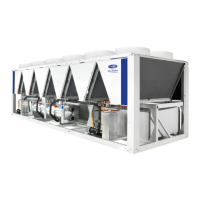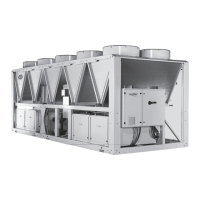28
7.11 - Head pressure control
For air-cooled units, the condensing pressure of each circuit
is generated by 10 fans maximum. As an option, a speed
variator can be used to control up to four fans so that the
speed of the fans is adjusted to maintain the head pressure
setpoint. The condensing pressure is independently controlled
in each circuit based on the saturated condensing temperature.
The control permanently adjusts its setpoint to guarantee
optimal performance and ensure anti-short-cycle protection
of the fans.
For water-cooled units, condensing pressure control is assured
if the three-way valve option is selected. The saturated
condensing temperature is controlled based on a user-
7.12 - Circuit lead/lag selection (multi-circuit units)
This function determines the lead and lag circuit on dual-
circuit or triple-circuit units. It controls the start/stop
sequence of the refrigeration circuits called circuit A, circuit
the same time should be decreased last when decreasing
capacity. The lead/lag circuits can be selected manually or
• Automatic lead/lag circuit determination: The control
system determines the lead circuit to equalise the operating
time of each circuit (value weighted by the number of
start-ups of each circuit). As a result, the circuit with the
• Manual lead/lag circuit determination: Circuit A, B or C
selected as the lead circuit. The selected circuit is always
7.13 - Compressor loading sequence (multi-circuit
units)
This function determines in which order the circuit capacity
is changed. Compressor loading is managed by starting/
stopping the compressors and controlling the position of the
slide valve. Two types of sequencing are available and can be
Balanced loading sequence: The control maintains equal
capacity between all circuits as the machine loads and
unloads.
Staged loading sequence: The control loads the lead circuit
completely before the lag circuits are started. When the load
Staged loading sequence is incorporated under the following
conditions:
• One of the circuits is shut down due to its failure
• One of the circuits is in capacity override mode
• Remaining circuits are shut down or fully charge
Loading sequence (%) Unloading sequence (%)
Lead circuit Lag circuit Lead circuit Lag circuit
0 0 100 100
30 (15) 0 100 95
35 0 95 95
40 0 95 90
45 0 90 90
50 0 90 85
55 0 85 85
60 0 85 80
65 0 80 80
70 0 80 75
70 30 (15) 75 75
70 35 75 70
70 40 70 70
70 45 70 65
70 50 65 65
70 55 65 60
70 65 60 60
70 70 60 55
75 70 55 55
75 75 55 50
80 75 50 50
80 80 50 45
85 80 45 45
85 85 45 40
90 85 40 40
90 90 40 35
95 90 40 30 (15)
95 95 40 0
100 95 35 0
100 100 30 (15) 0
100 100 0 0
Loading sequence (%) Unloading sequence (%)
Lead circuit Lag circuit Lead circuit Lag circuit
0 0 100 100
30 (15) 0 100 95
35 0 100 90
40 0 100 85
45 0 100 80
50 0 100 75
55 0 100 70
60 0 100 65
65 0 100 60
70 0 100 55
75 0 100 50
80 0 100 45
85 0 100 40
90 0 100 35
95 0 100 30 (15)
100 0 95 30 (15)
100 30 (15) 90 30 (15)
100 35 85 30 (15)
100 40 80 30 (15)
100 45 75 30 (15)
100 50 70 30 (15)
100 55 70 0
100 60 65 0
100 65 60 0
100 70 55 0
100 75 50 0
100 80 45 0
100 85 40 0
100 90 35 0
100 95 30 (15) 0
100 100 0 0
7.14 - Circuit capacity loading sequence
7.14.1 - Dual circuit – balanced capacity loading
7.14.2 - Dual circuit – priority given to one circuit
Note: (15) minimum capacity for standard water-cooled units (without the
option for high condensing temperature).

